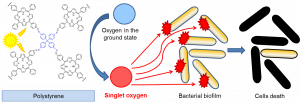Microbial colonies on the surfaces of medical devices contribute to outbreaks of serious patient infections. This is why we designed and prepared new materials that allow for dealing with this problem.
The solutions are based on polymer structures prepared by means of Schiff chemistry of bases that contain polymerized porphyrin macro cycles. After exposure to visible light, these polymers produce an excited form of oxygen, so-called singlet oxygen. Singlet oxygen is a reactive short-lived molecule. The high reactivity of singlet oxygen causes inactivation of bacterial colonies that are present on this material. This process is called antimicrobial photodynamic inactivation.
We proved that the best materials are three-dimensional structures. These polymers produce significant quantities of singlet oxygen after exposure to light, are photo-stable, demonstrate broad spectral area of action and are well dispersible in polystyrene layers. Upon these properties we can modify existing surfaces that then become antimicrobial. Due to this, these materials are perspective for biomedical applications.

The functioning of new polymer materials. The diagram shows a typical structure of porphyrin polymer materials and their function that is based on the adsorption of light in the visible range. The transfer of energy produces reactive singlet oxygen that eliminates biological films.
Hynek, J., Zelenka, J., Rathouský, J., Kubát, P., Ruml, T., Demel, J., Lang, K.*: Designing porphyrinic covalent organic frameworks for the photodynamic inactivation of bacteria. ACS Appl. Mater. Interfaces 2018, 10, 8527−8535; JRC/D1.
Collaboration: University of Chemistry and Technology Prague, J. Heyrovský Institute of Physical Chemistry under the Czech Academy of Sciences.